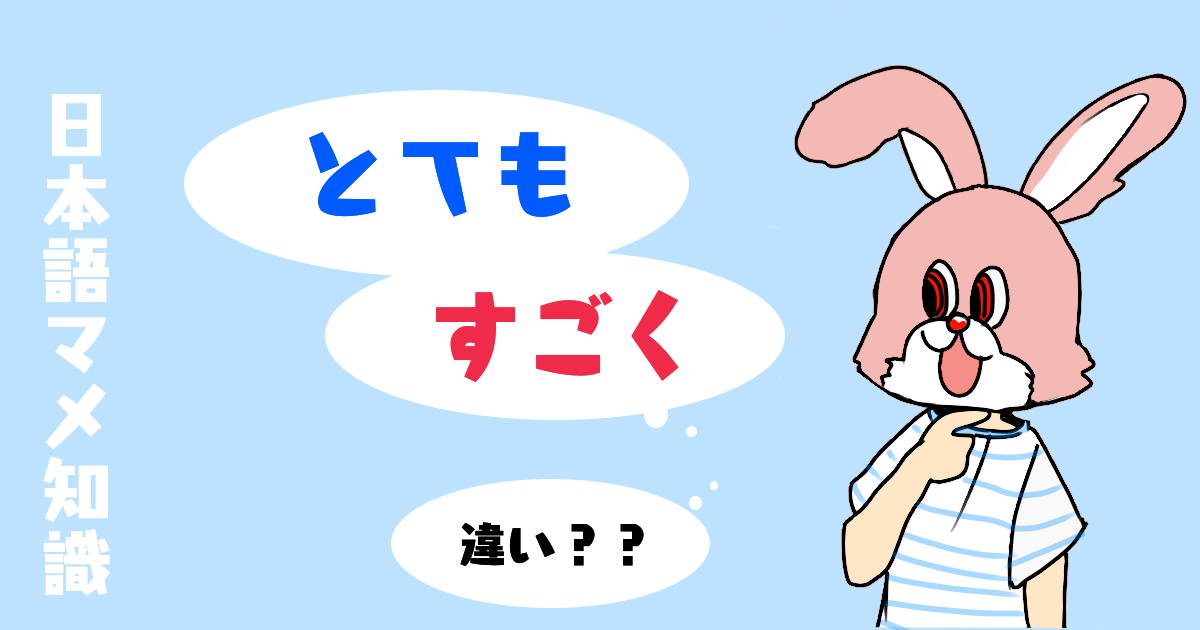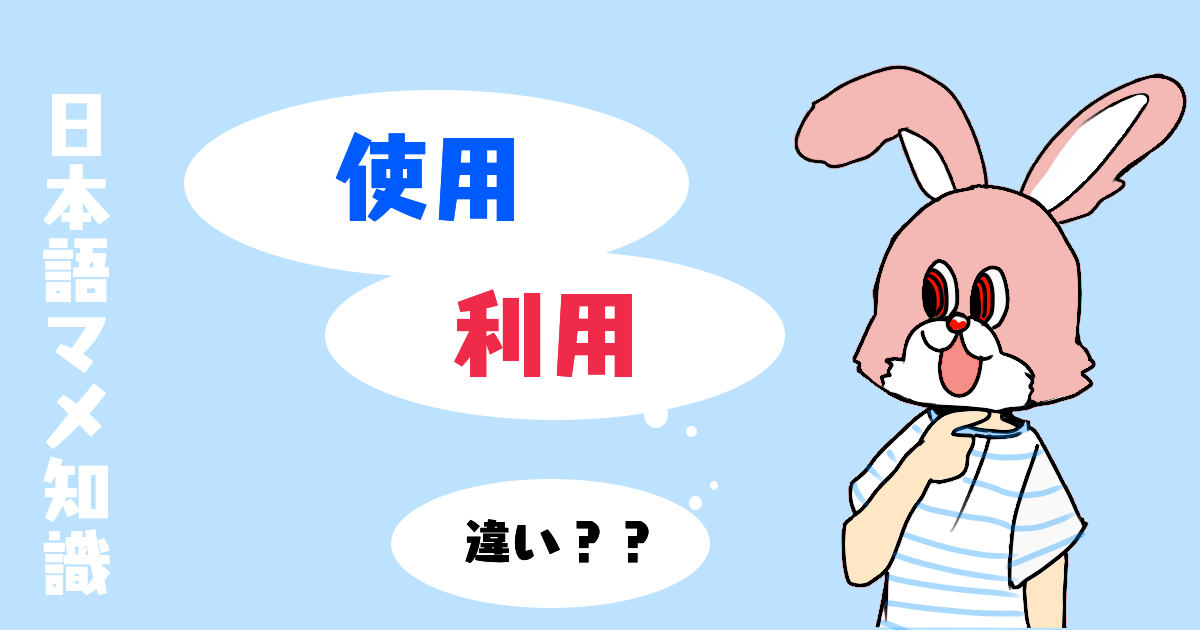
僕のIQは4000です。My IQ is 4000.

凄いIQ、先生すご~い。What an amazing IQ! You’re incredible, Sensei!

戦闘力は5万です。My combat power is 50,000.

凄い戦闘力、先生すご~い。What an incredible power level! You’re amazing, Sensei!

さて、夜のお店ごっこは終わりにして…敬語や丁寧な表現として「すごい+名詞」はおすすめできません。Alright, let’s stop playing “nightclub roleplay” for now… When it comes to polite or formal Japanese, using “sugoi + noun” isn’t recommended.

え!そうなんですか!先生凄い頭いい!凄い知識!すご~い!Eh?! Really? You’re so smart, Sensei! Such great knowledge! Amazing!
「とても」「すごく」は、どちらも日本語学習の初級から登場する言葉。教科書では「すごく」より「すごい!」とか「すごいですね。」という「すごい」が先に出てくることが多いです。
ここでは、「とても・すごく」の違い・言い換え・類語についてわかりやすく解説。「とても・凄く」がビジネス敬語や書き言葉に適しているかなども見ていきましょう。
Both “totemo” (very) and “sugoku” (really/very) are words that appear from the beginner level in Japanese learning. In most textbooks, “sugoi!” or “sugoi desu ne.” appears earlier than “sugoku.”
Here, we’ll clearly explain the differences, replacements, and synonyms of “totemo” and “sugoku,” and also look at whether “totemo/sugoku” are suitable for business or written Japanese.
「とても・すごく」の違いとは
「とても」と「すごく」はどちらも「程度が非常に高い様子」を表す日本語です。どちらも日常会話や文章で頻繁に使われますが、それぞれの使い方には微妙な違いがあります。では、それぞれどんな違いがあるのでしょうか。まずは、「とても」と「すごく」の意味と品詞(使い方)、英語の言い換え表現について詳しく解説します。
Both “totemo” and “sugoku” are Japanese words that express a very high degree or intensity of something. They are both frequently used in everyday speech and writing, but there are subtle differences in how they’re used. So, what are those differences? Let’s take a closer look at the meanings, grammatical roles, and English equivalents of “totemo” and “sugoku.”
「とても」の品詞・英語言い換え
- 意味:行為の程度がはなはだしいこと。非常に。Indicates that the degree of an action or state is very high.
- 品詞:副詞 Adverb
- 用法:書き言葉的で主に良いことに対して使われる。フォーマルな場面でも使える。Sounds more formal or literary, and is mainly used for positive situations. Suitable for formal contexts.
- 英語:very, extremely など
「とてもおいしい朝ごはんでした。」It was a very delicious breakfast.
「彼はとても頭が良い。」He is very smart.
「今日、とてもきれいな人を見ました。」I saw a very beautiful person today.
「すごく(すごい)」の品詞・英語言い換え
- 意味:行為の程度がはなはだしいこと。それ以上ない様子。おぞましい様子。Indicates an extreme degree; something exceptional or even overwhelming. Can also imply something dreadful or awe-inspiring.
- 品詞:「すごい」(形容詞)の連用形 The adverbial form of the いadjective “すごい”.
- 用法:口語的で良いことにも悪いことにも使われる。少しカジュアルな表現。More colloquial and can be used for both positive and negative situations. Slightly casual in tone.
- 英語:precious, (ネガティブな意味で)awfully など
「この料理はすごくおいしい。」This dish is extremely delicious.
「腰がすごく痛い。」My back really hurts.
「すごく嫌な気持ちになったんだ。」I felt really awful.
違いはポジティブ/ネガティブ・書き言葉/口語
前述した通り、「とても」はポジティブなことに使い、「すごく」はネガティブなことにも使われます。また、「とても」が書き言葉に適しているのに対して、「すごく」は話し言葉的でカジュアル。「すごく」はビジネスや敬語を使うシーン、作文やレポートなどでは好ましくありません。
As mentioned above, “totemo” tends to be used for positive expressions, while “sugoku” can be used for both positive and negative ones. Also, “totemo” fits better in written or formal contexts, whereas “sugoku” is more spoken and casual. Therefore, “sugoku” is not ideal for business situations, polite speech, essays, or formal reports.
「すごく おいしい」→OK
「すごく まずい。」→OK

しかし、会話の中で「とてもまずい」と言ったとしても強い違和感はないかもしれません。That said, saying “totemo mazui” in conversation wouldn’t sound terribly unnatural — it just feels a bit less common.
「すごく/すごい」どっちが正しい?品詞と例文
「すごい」は形容詞として名詞を修飾する際に使われ、「すごく」は動詞や形容詞を修飾します。次の例で確認しましょう。“Sugoi” is used as an adjective to modify nouns, while “sugoku” is used as an adverb to modify verbs or adjectives.
Let’s look at some examples:
すごく→用言(動詞・形容詞)verb/adjective

それでは、問題です。【すごい】の使い方で正しいものを以下から選んでください。Now, here’s a quiz: Which of the following sentences uses “sugoi” correctly?
①「彼はすごい選手である。」He’s an amazing athlete.
②「すごい可愛い服だね。」That’s a really cute outfit!
③「すごいイイじゃんこれ!」This is really good!
④「毎日早起きをするなんて、すごい。」It’s amazing that you wake up early every day.

正解は……①と④。②③も口語では間違いとは言いませんが、正しいとも言えません。どういうことでしょうか?Correct answers: ① and ④. Sentences ② and ③ aren’t grammatically correct in standard Japanese, though they’re often used in casual spoken language. So, why is that?
「すごい」は文末に使う、または体言(名詞)を修飾するのが正解。【すごく】は用言(動詞・形容詞)を修飾するのが正解。ただし、話し言葉では「すごいきれい」のように【すごい】+用言も使われます。The rule is: “Sugoi” is correct when used at the end of a sentence or to modify a noun. “Sugoku” is correct when modifying a verb or adjective. However, in spoken Japanese, people often say things like “sugoi kirei” (“so beautiful”) even though, strictly speaking, it should be “sugoku kirei.”
①「彼は無名から登り詰めたすごい選手である。」→すごい+名詞
②「すごい可愛い服だね。」→口語的。正しくは「すごく可愛い」
③「すごいイイじゃんこれ!」→口語的。正しくは「すごく良い」
④「毎日早起きをするなんて、君はすごい。」→すごい=形容詞
「とても・すごく」の言い換えは?
「すごい」という言葉はカジュアルな場面で広く使われますが、敬語や丁寧な表現を必要とするビジネスシーン、書き言葉では避けるべきです。敬語を使う際は、「非常に」「大変」などの言葉に言い換えるのが適切です。では、レポートや作文、ビジネスシーンで使える「とても」「すごい」の言い換え表現・類語を見ていきましょう。
The word “sugoi” is widely used in casual situations, but it should be avoided in formal or polite contexts, such as in business settings or written language.
When using keigo (polite or respectful language), it’s more appropriate to replace it with expressions like “hijō ni” (非常に) or “taihen” (大変). Let’s take a look at some suitable alternatives and synonyms for “totemo” and “sugoi” that can be used in reports, essays, and business situations.
類語「非常に」と「とても・すごく」の違い
「とても」や「すごく」と似た言葉で、ビジネスやレポートなどの書き言葉でよく使われる類語が、「非常に」です。「とても」「すごく」との意味の違いはなく、フォーマルでも良いこと、悪いことにも使われます。A word similar in meaning to “totemo” and “sugoku”, but often used in formal writing such as business documents or reports, is “hijō ni” (非常に). There is no significant difference in meaning between “hijō ni” and “totemo/sugoku,” but “hijō ni” sounds more formal and refined and can be used for both positive and negative situations.
- 意味:程度が極めて高いこと。Something of an extremely high degree.
- 品詞:副詞 Adverb
- 用法:良いことにも悪いことにも使われる。Can be used for both positive and negative situations; suitable for formal or written contexts.
- 英語:very, extremely, exceedingly など
「非常に大きな岩でした。」It was an extremely large rock.
「彼の能力は非常にたけている。」His abilities are exceptionally strong.
「非常に困難な状況だ。」It’s an extremely difficult situation.
類語「かなり」と「とても・すごく」の違い
「非常に」と同じく、「とても」「すごく」の類語としてよく使われるのが、「かなり」です。通常、「かなり」は「とても」「すごく」「非常に」より弱い度合の場合に使いますが、話し言葉では「非常に」の類義語として扱われます。Just like “hijō ni” (非常に), another common synonym of “totemo” and “sugoku” is “kanari” (かなり). Generally, “kanari” expresses a weaker degree than “totemo,” “sugoku,” or “hijō ni,” but in spoken Japanese, it’s often used as a near-synonym of “hijō ni.”
- 意味:(非常にとまではいかないが)程度が普通より勝っていること。(口語で)非常に。Indicates that something is above average in degree (though not to an extreme extent). In spoken language, it can also mean “very.”
- 品詞:副詞 Adverb
- 用法:良いことにも悪いことにも使われる。Can be used for both positive and negative situations.
- 英語:considerably, fairly など
「かなりの人数が集まりました。」(普通以上の人数)A considerable number of people gathered. (more than average)
「この問題はかなり難しいです。」(普通以上に難しい)This problem is quite difficult. (more difficult than usual)
「今回のテスト、かなり良い点とれたと思う。」(非常に)I think I got a really good score on this test. (very)

つまり、「かなり」の意味は①「非常にとまでいかないけれど、普通以上」②「非常に」の2種類あるんですね。In other words, “kanari” has two meanings: “More than average, but not to an extreme degree,” and “Very” (as in “hijō ni”) — when used in spoken Japanese.

もともとは①の「普通より」という意味でしたが、話し言葉で「非常に」の意味で広がりました。日本人の多くが、「非常に」と「かなり」を区別なく使っています。Originally, “kanari” carried only the first meaning (“above average”), but over time, its usage expanded in everyday speech to also mean “very.”
Today, many native Japanese speakers use “kanari” and “hijō ni” almost interchangeably.
その他の「とても・すごく」の言い換え表現
程度を表す「とても」や「すごく」の言い換えや類語はとても多いです。There are many alternative expressions and synonyms that can replace “totemo” or “sugoku” to indicate degree or intensity in Japanese.
「ひどく気に入った様子でした。」He seemed to like it terribly much.
「誠にありがたいお言葉です。」Your words are truly appreciated.
「何より可愛い女の子。」An exceptionally cute girl. / A girl cuter than anyone else.
「きわめて珍しい動物です。」It’s an extremely rare animal.
「大変おいしい料理でした。」It was a very delicious dish.
「すこぶる元気な男の子。」An exceedingly energetic boy.
「痛く感動しました。」I was deeply moved. (literally “painfully moved”)
「大層美しい女性が住んでいた。」There lived a very beautiful woman. (slightly old-fashioned expression)
「とても・すごく」のスラング言い換え
若い日本人の会話を聞いているとよくわかりますが、「とても」「すごく」の言い換え表現は、方言やスラングを含めると「めっちゃ」多いです。If you listen to conversations among young Japanese people, you’ll quickly notice that there are so many slang and dialectal alternatives to “totemo” and “sugoku.” In fact, there are “meccha” (tons of) ways to say it!
「とても」「すごく」や上の例のような強調語は、スラングが非常に多い言葉。さらに、本来スラングではない方言が東京近辺の若者にも使われスラング化しつつあります。Words like “totemo” and “sugoku,” as well as these kinds of intensifiers, have countless slang variations. What’s more, some expressions that originally came from regional dialects are now being used by young people in the Tokyo area, effectively turning them into slang too. If you’re interested in learning more about Japanese slang, check out the resources below!
参考:海外の反応「日本語は悪口が少ない」は本当?日本のスラング一覧
「とても」今と昔の意味の違い
実は、「とても」の意味は昔と今で違いがあります。古語で「とても」は、「とて(迚)もかくても」の略で、「とても~できない」の用法で使われました。「とても=非常に」と意味は違いますが、「とても~できない」は今も使われる表現ですね。Interestingly, the meaning of “totemo” has changed over time. In classical Japanese, totemo was a shortened form of “tote mo kakute mo” (迚もかくても) and was used in expressions like “totemo 〜 dekinai” (cannot possibly 〜). In that sense, it did not mean “very” or “extremely” as it does today.
However, the expression “totemo 〜 dekinai” (can’t possibly 〜) is still commonly used in modern Japanese.
「とてもかくても」の品詞・英語言い換え
- 意味:どうせ、結局は。どんなにしても~ない。No matter what; in any case; impossible to do.
- 品詞:副詞 Adverb
- 用法:後に打ち消しの言葉を伴って、「とても~ない」「とても~(である)まい」Followed by a negative expression, as in “とても〜ない” or “とても〜まい.”
- 英語言い換え:no matter how, even if, even though
「わたしにはとても真似できまい。」(古い)I could never imitate that.
「富士山なんてとても登りきれまい。」(古い)There’s no way I could climb Mt. Fuji.
口語だと、「とても~ない」が一般的で、「~まい」は少し古い言い回しに聞こえます。「とても~ない」の形が、現代では【とても】だけで使えるようになったのだと言われています。In spoken modern Japanese, the form “とても〜ない” is the standard, while “〜まい” sounds rather old-fashioned or literary. It’s said that the modern use of “totemo” as simply meaning “very” developed from this older “totemo 〜 nai” structure over time.

漫画とかでは結構使ってるキャラ(おじいちゃんキャラとか)を見かけますけどね。You might still encounter the old-fashioned “totemo 〜 mai” form in manga or period dramas, often spoken by elderly or traditional characters.
参考:漫画アニメの中国人はなぜ「あるある」言う?お嬢様は「ですわ」?
まとめ
- 「とても」と「すごく」の違い
「とても」は、良いことに使う副詞
「すごく」は、良いことにも悪いことにも使う形容詞(カジュアル)
- 「すごい」の正しい使い方
形容詞文で使用/名詞に付ける
それ以外は口語的。敬語を使うフォーマルシーンではNG
- 「非常に」は「とても」と意味・用法ともにほとんど同じ
- 「かなり」には2種類の意味がある
「とても」「すごく」より程度が少ない
「とても」「すごく」と同じ意味(口語の場合)
前回記事:【以来】と【以降】の違いとは?
次回記事:【制作】と【製作】の違いとは?




コメント